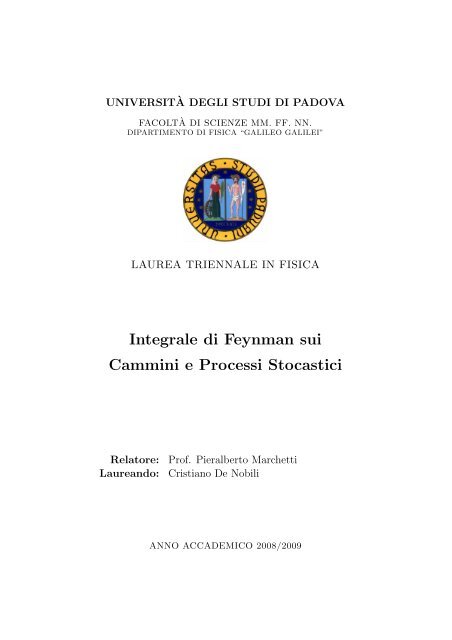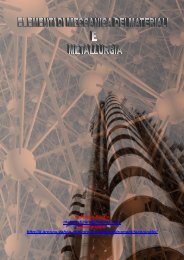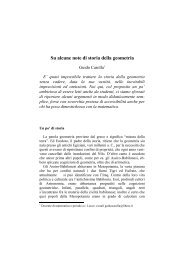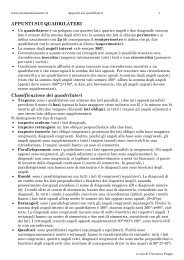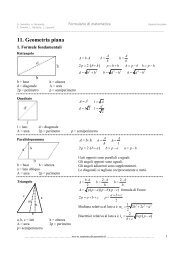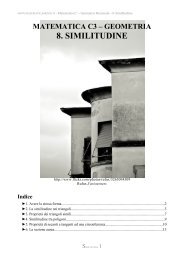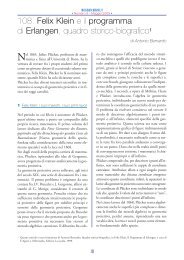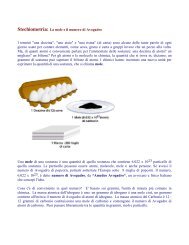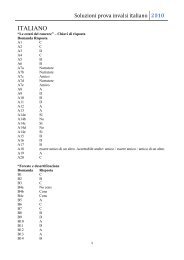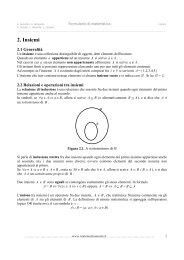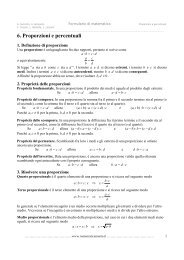Scarica la tesi Integrale di Feynman sui Cammini e Processi Stocastici
Scarica la tesi Integrale di Feynman sui Cammini e Processi Stocastici
Scarica la tesi Integrale di Feynman sui Cammini e Processi Stocastici
Create successful ePaper yourself
Turn your PDF publications into a flip-book with our unique Google optimized e-Paper software.
UNIVERSITÀ DEGLI STUDI DI PADOVA<br />
FACOLTÀ DI SCIENZE MM. FF. NN.<br />
DIPARTIMENTO DI FISICA “GALILEO GALILEI”<br />
LAUREA TRIENNALE IN FISICA<br />
<strong>Integrale</strong> <strong>di</strong> <strong>Feynman</strong> <strong>sui</strong><br />
<strong>Cammini</strong> e <strong>Processi</strong> <strong>Stocastici</strong><br />
Re<strong>la</strong>tore: Prof. Pieralberto Marchetti<br />
Laureando: Cristiano De Nobili<br />
ANNO ACCADEMICO 2008/2009
In<strong>di</strong>ce<br />
0.1 Introduzione . . . . . . . . . . . . . . . . . . . . . . . . . . . . . . 1<br />
0.2 Derivazione dell’<strong>Integrale</strong> <strong>sui</strong> <strong>Cammini</strong> <strong>di</strong> <strong>Feynman</strong> attraverso <strong>la</strong><br />
Formu<strong>la</strong> <strong>di</strong> Trotter. . . . . . . . . . . . . . . . . . . . . . . . . . . 1<br />
0.3 Formu<strong>la</strong>zione <strong>di</strong> <strong>Feynman</strong> del<strong>la</strong> Meccanica Quantistica: Postu<strong>la</strong>ti. 4<br />
0.4 Natura e Caratteristiche dei <strong>Cammini</strong> <strong>di</strong> <strong>Feynman</strong>. . . . . . . . . 5<br />
0.5 Ambiguità <strong>di</strong> Quantizzazione dell’<strong>Integrale</strong> <strong>di</strong> <strong>Feynman</strong> . . . . . 7<br />
0.6 Equivalenza tra <strong>la</strong> Formu<strong>la</strong>zione <strong>di</strong> <strong>Feynman</strong> e <strong>la</strong> Formu<strong>la</strong>zione<br />
Standard del<strong>la</strong> MQ . . . . . . . . . . . . . . . . . . . . . . . . . . 8<br />
0.7 Problematiche <strong>di</strong> Convergenza dell’<strong>Integrale</strong> <strong>di</strong> <strong>Feynman</strong> . . . . . 9<br />
0.8 La Formu<strong>la</strong> <strong>di</strong> <strong>Feynman</strong>-Kac e <strong>la</strong> Misura <strong>di</strong> Wiener. . . . . . . . 10<br />
0.9 Equazione del Calore e Moto Browniano . . . . . . . . . . . . . . 12<br />
0.10 <strong>Integrale</strong> <strong>di</strong> <strong>Feynman</strong> e <strong>Integrale</strong> <strong>di</strong> Wiener . . . . . . . . . . . . 14<br />
0.11 Equazione <strong>di</strong> Fokker-P<strong>la</strong>nck e Fluttuazioni Quantistiche . . . . . 15<br />
.1 Appen<strong>di</strong>ce A: Derivazione dell’<strong>Integrale</strong> <strong>di</strong> <strong>Feynman</strong> attraverso<br />
l’Operatore Normalmente Or<strong>di</strong>nato . . . . . . . . . . . . . . . . . 17<br />
.2 Appen<strong>di</strong>ce B: un paio <strong>di</strong> Definizioni e un Teorema . . . . . . . . 19<br />
Bibliografia 20<br />
.3 Ringraziamenti . . . . . . . . . . . . . . . . . . . . . . . . . . . . 20
0.1 Introduzione<br />
In questo <strong>la</strong>voro si presenta ed e<strong>la</strong>bora concettualmente <strong>la</strong> Formu<strong>la</strong>zione <strong>di</strong> <strong>Feynman</strong><br />
del<strong>la</strong> Meccanica Quantistica (MQ), i problemi <strong>di</strong> convergenza dell’integrale<br />
<strong>sui</strong> cammini e <strong>la</strong> re<strong>la</strong>zione <strong>di</strong> questa formu<strong>la</strong>zione con i processi stocastici. Dapprima,<br />
nel<strong>la</strong> sezione {0.2}, viene derivato l’integrale <strong>sui</strong> cammini <strong>di</strong> <strong>Feynman</strong><br />
attraverso l’utilizzo del<strong>la</strong> formu<strong>la</strong> <strong>di</strong> Trotter e successivamente, nel<strong>la</strong> sezione<br />
{0.3}, sono presentati i postu<strong>la</strong>ti del<strong>la</strong> formu<strong>la</strong>zione <strong>di</strong> <strong>Feynman</strong> del<strong>la</strong> MQ. Sono<br />
poi stu<strong>di</strong>ati i cammini <strong>di</strong> <strong>Feynman</strong> e le loro caratteristiche peculiari, che offrono<br />
uno stretto paragone con i processi stocastici. Nelle sezioni {0.7},{0.8} vengono<br />
prima mostrate le problematiche <strong>di</strong> convergenza dell’integrale <strong>di</strong> <strong>Feynman</strong> e poi,<br />
seguendo <strong>la</strong> <strong>di</strong>mostrazione <strong>di</strong> Nelson del teorema <strong>di</strong> Kolmogorov, l’approccio <strong>di</strong><br />
Kac che permette <strong>di</strong> definire rigorosamente una misura per l’integrale: <strong>la</strong> misura<br />
<strong>di</strong> Wiener. Nel<strong>la</strong> sezione {0.9} è mostrata l’equazione del calore e <strong>la</strong> sua stretta<br />
re<strong>la</strong>zione con il moto browniano, esempio più semplice <strong>di</strong> processo stocastico.<br />
Ciò ci permette, nelle due sezioni successive, <strong>di</strong> paragonare <strong>di</strong>rettamente prima<br />
l’integrale <strong>di</strong> <strong>Feynman</strong> con quello <strong>di</strong> Wiener e poi l’equazione <strong>di</strong> Schrö<strong>di</strong>nger<br />
con quel<strong>la</strong> <strong>di</strong> Fokker-P<strong>la</strong>nk. Da questo confronto si conclude che l’evoluzione<br />
temporale <strong>di</strong> una particel<strong>la</strong> quantistica può essere descritta come un’evoluzione<br />
deterministica perturbata da fluttuazioni quantistiche.<br />
0.2 Derivazione dell’<strong>Integrale</strong> <strong>sui</strong> <strong>Cammini</strong> <strong>di</strong><br />
<strong>Feynman</strong> attraverso <strong>la</strong> Formu<strong>la</strong> <strong>di</strong> Trotter.<br />
Consideriamo inizialmente l’equazione <strong>di</strong> Schrö<strong>di</strong>nger <strong>di</strong> una particel<strong>la</strong> non<br />
re<strong>la</strong>tivistica in moto uni<strong>di</strong>mensionale in presenza <strong>di</strong> un potenziale sca<strong>la</strong>re V (x):<br />
i¯h ∂<br />
¯h2<br />
ψ(x, t) = −<br />
∂t 2m<br />
∂ 2<br />
ψ(x, t) + V (x)ψ(x, t) (1)<br />
∂x2 Un’arbitraria soluzione <strong>di</strong> tale equazione, in<strong>di</strong>viduata dal<strong>la</strong> con<strong>di</strong>zione iniziale<br />
ψ(x0, t0), può essere scritta attraverso <strong>la</strong> Funzione <strong>di</strong> Green o anche detta in<br />
meccanica quantistica propagatore 〈x, t|x0, t0〉 1 :<br />
ψ(x, t) =<br />
+∞<br />
−∞<br />
dx0〈x, t|x0, t0〉ψ(x0, t0) (2)<br />
Il termine propagatore in<strong>di</strong>ca il significato fisico <strong>di</strong> tale funzione; infatti essa<br />
rappresenta l’ampiezza <strong>di</strong> probabilità <strong>di</strong> passare da x0 all’istante t0 a x all’istante<br />
t, cioè da (x0, t0) a (x, t). L’importanza del propagatore e dell’approccio<br />
<strong>di</strong> <strong>Feynman</strong> è che tale oggetto matematico permette <strong>di</strong> calco<strong>la</strong>re un’arbitraria<br />
soluzione dell’equazione <strong>di</strong> Schrö<strong>di</strong>nger, senza dover risolvere esplicitamente <strong>la</strong><br />
(1).<br />
Ciò che faremo ora è indagare <strong>la</strong> natura <strong>di</strong> tale propagatore; otterremo così<br />
l’integrale <strong>di</strong> <strong>Feynman</strong>. Sia H l’operatore hamiltoniana e assumiamo H = T + V ,<br />
dove T rappresenta l’operatore energia cinetica e V quello energia potenziale.<br />
Fissiamo l’attenzione sul propagatore 〈x ′′ , t ′′ |x ′ , t ′ 〉 dallo stato (x ′ , t ′ ) a (x ′′ , t ′′ ).<br />
1 In questo e<strong>la</strong>borato successivamente il propagatore verrà in<strong>di</strong>cato anche con G(x, x0; t, t0).<br />
Si ha che G(x, x0; t0, t0) = δ(x − x0), come è facile da verificare.<br />
1
Esso può anche essere scritto:<br />
〈x ′′ , t ′′ |x ′ , t ′ 〉 = 〈x ′′ i −<br />
|e ¯h (t′′ −t ′ )(T +V ) ′<br />
|x 〉 (3)<br />
Poichè T e V non commutano si ha che e T +V = e T · e V , ma vale <strong>la</strong> seguente<br />
Formu<strong>la</strong> <strong>di</strong> Trotter:<br />
(4)<br />
e T +V = lim<br />
N→+∞ (eT /N e V /N ) N<br />
Nel nostro caso dunque, ponendo λ = i<br />
¯h (t′′ − t):<br />
〈x ′′ , t ′′ |x ′ , t ′ 〉 = lim<br />
N→+∞ 〈x′′ |(e −λT /N e −λV /N ) N |x ′ 〉 (5)<br />
Utilizzando ora <strong>la</strong> re<strong>la</strong>zione <strong>di</strong> completezza per gli autostati generalizzati<br />
dell’operatore posizione<br />
+∞<br />
−∞<br />
|x〉〈x|dx = 1<br />
e inserendo tale espressione nell’equazione (5), fra gli N fattori e−λT /N −λV /N e<br />
si ottiene per il propagatore tale espressione:<br />
〈x ′′ , t ′′ |x ′ , t ′ +∞<br />
〉 = lim<br />
N→+∞ −∞<br />
...<br />
+∞<br />
−∞<br />
<br />
N−1 <br />
i=1<br />
<br />
N−1 <br />
dxi<br />
j=0<br />
〈xj+1|e −λT /N e −λV /N |xj〉<br />
(6)<br />
Tale espressione esprime il propagatore 〈x ′′ , t ′′ |x ′ , t ′ 〉 in funzione del propagatore<br />
infini<strong>tesi</strong>mo 〈xj+1|e −λT /N e −λV /N |xj〉.<br />
Vogliamo ora calco<strong>la</strong>re tale propagatore infini<strong>tesi</strong>mo. Siccome V = V (x),<br />
allora si ha:<br />
〈xj+1|e −λT /N e −λV /N |xj〉 = e −λV (xj)/N 〈xj+1|e −λT /N |xj〉 (7)<br />
Analogamente al<strong>la</strong> re<strong>la</strong>zione <strong>di</strong> completezza per gli autostati generalizzati dell’operatore<br />
posizione, abbiamo per quelli dell’operatore impulso:<br />
Ciò ci permette <strong>di</strong> scrivere:<br />
+∞<br />
−∞<br />
|p〉〈p|dp = 1<br />
〈xj+1|e −λT /N +∞<br />
|xj〉 = dpj〈xj+1|e<br />
−∞<br />
−λT /N |pj〉〈pj|xj〉<br />
Sapendo che nel caso considerato T = p 2 /2m e che tale operatore è <strong>di</strong>agonale<br />
nel<strong>la</strong> rappresentazione dell’impulso:<br />
Quin<strong>di</strong>:<br />
〈xj+1|e −λT /N |pj〉 = e −λp2<br />
j /2mN 〈xj+1|pj〉<br />
〈xj+1|e −λT /N +∞<br />
|xj〉 = dpje<br />
−∞<br />
−λp2 /2mN<br />
〈xj+1|pj〉〈pj|xj〉<br />
2
Ma un’espressione del tipo 〈x|p〉 rappresenta l’autofunzione impulso nel<strong>la</strong><br />
rappresentazione delle coor<strong>di</strong>nate, quin<strong>di</strong> (per una particel<strong>la</strong> libera):<br />
〈xj+1|pj〉〈pj|xj〉 = 1<br />
√ e<br />
2π¯h (i/¯h)pjxj+1 1<br />
√2π¯h e −(i/¯h)pjxj<br />
Si ottiene dunque l’integrale gaussiano<br />
〈xj+1|e −λT /N |xj〉 = 1<br />
2π¯h<br />
e integrando si ottiene:<br />
〈xj+1|e −λT /N |xj〉 =<br />
mN<br />
2π¯h 2 λ<br />
+∞<br />
−∞<br />
dpje −λp2<br />
j /2mN e ipj(xj+1−xj)/¯h<br />
1<br />
2<br />
exp{−(m/2)(xj+1 − xj) 2 N/λ¯h} (8)<br />
Inserendo l’eq.(8) nell’eq.(7), otteniamo per il propagatore infini<strong>tesi</strong>mo l’espressione<br />
〈xj+1|e −λT /N e −λV /N |xj〉 =<br />
1 <br />
2<br />
m<br />
exp (i/¯h)ɛ<br />
2<br />
<br />
mN<br />
2π¯h 2 λ<br />
<br />
2<br />
xj+1 − xj<br />
− V (xj)<br />
ɛ<br />
(9)<br />
Con ɛ = (t′′ −t ′ )<br />
. Questa forma del propagatore infini<strong>tesi</strong>mo fu suggerita<br />
N<br />
già da Dirac[6], tuttavia egli non fu in grado <strong>di</strong> collegar<strong>la</strong> con il propagatore<br />
〈x ′′ , t ′′ |x ′ , t ′ 〉 re<strong>la</strong>tivo ad un tempo finito. E’ merito <strong>di</strong> <strong>Feynman</strong> il fatto <strong>di</strong> aver<br />
espresso il propagatore come infinite convoluzioni del propagatore infini<strong>tesi</strong>mo<br />
secondo l’eq.(6) [2]. Utilizzando dunque l’eq.(9)<br />
〈x ′′ , t ′′ |x ′ , t ′ <br />
mN<br />
〉 = lim<br />
N→+∞ 2π¯h 2 N<br />
2<br />
λ<br />
+∞<br />
...<br />
−∞<br />
+∞<br />
−∞<br />
<br />
N−1 <br />
i=1<br />
dxi<br />
<br />
N−1 <br />
j=0<br />
<br />
m<br />
exp (i/¯h)ɛ<br />
(10)<br />
Utilizzando le proprietà del<strong>la</strong> funzione esponenziale si ha che il prodotto si<br />
trasforma in somma e dunque<br />
〈x ′′ , t ′′ |x ′ , t ′ <br />
mN<br />
〉 = lim<br />
N→+∞ 2π¯h 2 N<br />
2<br />
λ<br />
+∞<br />
...<br />
−∞<br />
+∞<br />
−∞<br />
⎧<br />
N−1 ⎨<br />
dxi exp<br />
⎩ (i/¯h)ɛ<br />
N−1 <br />
<br />
m<br />
(11)<br />
Questa è <strong>la</strong> forma finale del Propagatore Quantistico, espresso come <strong>Integrale</strong><br />
<strong>di</strong> <strong>Feynman</strong> [1]. Il limite N → ∞ equivale a ɛ → 0.<br />
A questo punto un Cammino <strong>di</strong> <strong>Feynman</strong> (<strong>di</strong>scretizzato) è rappresentato da<br />
una spezzata ΓN(..., x(tk), ...) <strong>di</strong> vertici {x ′ , x1, ..., xk, ..., xN−1, x ′′ }, con x(t ′ ) =<br />
x ′ , x(tk) = xk, x(t ′′ ) = x ′′ . Tale spezzata si ottiene <strong>di</strong>scretizzando l’intervallo<br />
<strong>di</strong> tempo considerato (t ′′ − t ′ ) in N-1 punti interme<strong>di</strong> equi<strong>di</strong>stanti e spaziati <strong>di</strong><br />
ɛ.Se in<strong>di</strong>chiamo con CN (x ′ , t ′ ; x ′′ , t ′′ ) l’insieme <strong>di</strong> tutte le ΓN con estremi fissi<br />
x(t ′ ) = x ′ , x(t ′′ ) = t ′′ , allora l’eq.(11) in<strong>di</strong>ca, per N fissato, <strong>la</strong> somma <strong>di</strong> exp{...}<br />
su CN 2 .<br />
2 Notiamo infatti che tale integrazione non coinvolge i punti estremi, ma solo quelli<br />
interme<strong>di</strong>.<br />
3<br />
i=1<br />
j=0<br />
2 (xj+1 − xj<br />
)<br />
ɛ<br />
2 − V (xj)<br />
2 (xj+1 − xj<br />
)<br />
ɛ<br />
2 − V (xj)<br />
<br />
⎫ ⎬<br />
⎭
Sapendo che ( xj+1−xj<br />
ɛ<br />
S[x(·)] t′′<br />
t ′ =<br />
) 2 = ( x(tj+1)−x(tj)<br />
ɛ ) 2 e che l’azione c<strong>la</strong>ssica è<br />
t ′′<br />
t ′<br />
dt<br />
<br />
1<br />
2 m ˙x(t)2 <br />
− V (x(t))<br />
(12)<br />
allora è facile vedere che il termine ɛ [...] dell’eq.(11), ad N fissato, è proprio<br />
tale azione c<strong>la</strong>ssica calco<strong>la</strong>ta lungo <strong>la</strong> spezzata ΓN.<br />
Nel limite limN→+∞, <strong>la</strong> spezzata ΓN <strong>di</strong>venta una curva continua x(t) con<br />
stessi estremi fissi. L’insieme CN (x ′ , t ′ ; x ′′ , t ′′ ) <strong>di</strong>venta lo spazio dei cammini<br />
C(x ′ , t ′ ; x ′′ , t ′′ ), cioè l’insieme delle funzioni reali continue x(t) con estremi<br />
x(t ′ ) = x ′ , x(t ′′ ) = x ′′ . L’eq.(11) può dunque essere riscritta in maniera poco<br />
rigorosa:<br />
〈x ′′ , t ′′ |x ′ , t ′ 〉 =<br />
<br />
<br />
m<br />
Dx(t) = lim<br />
N→+∞ 2πi¯hɛ<br />
C<br />
Dx(t) · exp{(i/¯h)S[x(·)] t′′<br />
t ′ } (13)<br />
N/2 N−1 <br />
i=1<br />
dx(ti)<br />
Nell’eq.(13) si vede che per N → ∞ il termine Dx(t) è <strong>di</strong>vergente, mentre il<br />
temine exp{(i/¯h)S[x(·)] t′′<br />
t ′ }, oscil<strong>la</strong>ndo rapidamente, tende ad eliminare questa<br />
<strong>di</strong>vergenza facendo si che nell’espressione (11) il limite esiste. Tuttavia, come<br />
sarà mostrato nel<strong>la</strong> sezione 0.7, il prodotto <strong>di</strong> questi due fattori non è in grado<br />
<strong>di</strong> definire una misura per l’integrale funzionale. Quin<strong>di</strong> si ha che l’espressione<br />
(13) non è matematicamente corretta. Per il momento però trascuriamo questo<br />
aspetto e ci concentriamo sul significato fisico <strong>di</strong> questo risultato, che verrà<br />
espresso nel<strong>la</strong> prossima sezione.<br />
0.3 Formu<strong>la</strong>zione <strong>di</strong> <strong>Feynman</strong> del<strong>la</strong> Meccanica<br />
Quantistica: Postu<strong>la</strong>ti.<br />
Consideriamo una particel<strong>la</strong> S descritta dall’azione c<strong>la</strong>ssica (12) e fissiamo l’attenzione<br />
sull’evento A: S va da (x ′ , t ′ ) a (x ′′ , t ′′ ). L’ampiezza 〈x ′′ , t ′′ |x ′ , t ′ 〉 associata<br />
a questo evento è il propagatore dell’equazione <strong>di</strong> Schrö<strong>di</strong>nger nelle varibili<br />
(x ′′ , t ′′ ).<br />
Postu<strong>la</strong>to 1 Tutte le alternative <strong>di</strong>sgiunte (cioè in<strong>di</strong>pendenti mutuamente esclusive)<br />
secondo le quali l’evento A può realizzarsi sono descritte da cammini<br />
x(t) ∈ C(x ′ , t ′ ; x ′′ , t ′′ ).<br />
L’idea fondamentale <strong>di</strong> <strong>Feynman</strong> è <strong>di</strong> associare un’ampiezza <strong>di</strong> probabilità ad<br />
ogni alternativa <strong>di</strong>sgiunta re<strong>la</strong>tiva all’evento A in questione. Nel<strong>la</strong> formu<strong>la</strong>zione<br />
standard si associa invece un’ampiezza <strong>di</strong> probabilità, ψ(x, t), al<strong>la</strong> posizione <strong>di</strong><br />
una particel<strong>la</strong> ad un partico<strong>la</strong>re istante.<br />
Esprimiamo l’ampiezza che S si muova lungo x(t) con 〈x ′′ , t ′′ |x ′ , t ′ 〉[x(·)].<br />
Postu<strong>la</strong>to 2 I cammini x(t) ∈ C(x ′ , t ′ ; x ′′ , t ′′ ) contribuiscono ugualmente in<br />
modulo, ma <strong>la</strong> fase dei loro contributi è data dall’azione c<strong>la</strong>ssica (in unità <strong>di</strong> ¯h),<br />
cioè dall’integrale temporale del<strong>la</strong> <strong>la</strong>grangiana calco<strong>la</strong>to lungo il cammino.<br />
〈x ′′ , t ′′ |x ′ , t ′ 〉[x(·)] = exp{(i/¯h)S[x(·)] t′′<br />
t ′ }<br />
4
Il terzo postu<strong>la</strong>to è motivato dal fatto che le ampiezze quantistiche sod<strong>di</strong>sfano<br />
il Principio <strong>di</strong> Sovrapposizione. Tale principio implica che l’ampiezza totale<br />
〈x ′′ , t ′′ |x ′ , t ′ 〉 per l’evento A debba essere <strong>la</strong> somma delle ampiezze 〈x ′′ , t ′′ |x ′ , t ′ 〉[x(·)]<br />
re<strong>la</strong>tive ad ogni singo<strong>la</strong> alternativa <strong>di</strong>sgiunta. Quin<strong>di</strong>:<br />
Postu<strong>la</strong>to 3 Il Propagatore Quantistico è dato da<br />
<br />
〈x ′′ , t ′′ |x ′ , t ′ 〉 =<br />
Questa ultima espressione è l’eq.(13).<br />
Dx(t)〈x<br />
C<br />
′′ , t ′′ |x ′ , t ′ 〉[x(·)].<br />
0.4 Natura e Caratteristiche dei <strong>Cammini</strong> <strong>di</strong> <strong>Feynman</strong>.<br />
I <strong>Cammini</strong> <strong>di</strong> <strong>Feynman</strong> hanno significato fisico?<br />
Consideriamo una regione R dello spazio dei cammini C(x ′ , t ′ ; x ′′ , t ′′ ), R ⊂ C.<br />
Partendo dai postu<strong>la</strong>ti, vogliamo mostrare che non esiste alcuna <strong>di</strong>stribuzione<br />
c<strong>la</strong>ssica <strong>di</strong> probabilità definita sullo spazio dei cammini C. Consideriamo un<br />
generico cammino x(t) ∈ C. La probabilità che <strong>la</strong> particel<strong>la</strong> S si muova lungo<br />
tale cammino x(t) è<br />
P (x ′ , t ′ ; x ′′ , t ′′ )[x(t)] = |〈x ′′ , t ′′ |, x ′ , t ′ 〉[x(t)]| 2<br />
(14)<br />
Ora secondo il calcolo c<strong>la</strong>ssico delle probabilità si dovrebbe avere che <strong>la</strong> probabilità<br />
che il generico cammino sia contenuto in R è:<br />
<br />
P rob{x(t) ∈ R} = Dx(t)P (x ′′ , t ′′ ; x ′ , t ′ )[x(·)] (15)<br />
R<br />
Seguendo invece i postu<strong>la</strong>ti <strong>di</strong> <strong>Feynman</strong> il risultato è <strong>di</strong>verso; ve<strong>di</strong>amo in<br />
che senso. Per il Postu<strong>la</strong>to 3 l’ampiezza <strong>di</strong> probabilità <strong>di</strong> trovare il generico<br />
cammino x(t) nel<strong>la</strong> regione R ∈ C è:<br />
<br />
Amp{x(t) ∈ R} = Dx(t)〈x ′′ , t ′′ |x ′ , t ′ 〉[x(·)].<br />
Dunque dall’eq.(14) segue che:<br />
<br />
P rob{x(t) ∈ R} = |<br />
R<br />
Dx(t)〈x<br />
R<br />
′′ , t ′′ |x ′ , t ′ 〉[x(·)] | 2 . (16)<br />
Abbiamo dunque che l’eq.(15) è <strong>di</strong>fferente dall’eq.(16)<br />
<br />
<br />
Dx(t)|〈x<br />
R<br />
′′ , t ′′ |x ′ , t ′ 〉[x(·)]| 2 = |<br />
Dx(t)〈x<br />
R<br />
′′ , t ′′ |x ′ , t ′ 〉[x(·)] | 2 . (17)<br />
Questo risultato sottolinea <strong>la</strong> non vali<strong>di</strong>tà del calcolo delle probabilità c<strong>la</strong>ssico<br />
in MQ. Ciò suggerisce che i cammini <strong>di</strong> <strong>Feynman</strong> non possono essere visti<br />
come possibili traiettorie descritte da una particel<strong>la</strong> in accordo con il senso<br />
comune. Per sottolineare <strong>la</strong> non realtà <strong>di</strong> tali cammini lo stesso <strong>Feynman</strong> suggerisce<br />
<strong>di</strong> pensare che <strong>la</strong> particel<strong>la</strong> percorra simultaneamente tutti i cammini 3 .<br />
E’ noto infatti che in MQ non è possibile attribuire proprietà fisiche ben definite<br />
ad oggetti non osservati!<br />
3 Questa idea è analoga all’esperimento delle due fen<strong>di</strong>ture: l’elettrone passa per entrambe.<br />
5
Caratteristiche dei <strong>Cammini</strong> <strong>di</strong> <strong>Feynman</strong><br />
Iniziamo a considerare l’eq.(11) e notiamo che ai fini dell’integrazione è importante<br />
il valore del<strong>la</strong> fase del<strong>la</strong> funzione exp{i...}. Se <strong>la</strong> fase varia molto<br />
rapidamente si ha che i vari contributi si cancel<strong>la</strong>no a vicenda e che quin<strong>di</strong> i<br />
cammini che determinano tale fase non contribuiscono in modo essenziale al<strong>la</strong><br />
somma. In modo semplice può essere visto che il contributo fondamentale è<br />
dato da quei fattori per cui il termine<br />
2 xj+1 − xj<br />
ɛ<br />
si mantiene finito per ɛ → 0<br />
ɛ<br />
Da questa considerazione deriva un importante risultato: I cammini che<br />
danno un contributo non nullo all’integrale <strong>di</strong> <strong>Feynman</strong> sono solo quelli che<br />
godono del<strong>la</strong> proprietà:<br />
∆x(t) ∼ (∆t) 1<br />
2 (18)<br />
Tali cammini (appunto i <strong>Cammini</strong> <strong>di</strong> <strong>Feynman</strong>) risultano essere continui,<br />
ma non <strong>di</strong>fferenziabili, infatti:<br />
∆x(t)<br />
lim = lim<br />
∆t→0 ∆t ∆t→0<br />
1<br />
√ ∆t = ∞<br />
Per tale motivo si <strong>di</strong>ce che essi siano frattali con <strong>di</strong>mensione <strong>di</strong> Hausdorff 4 uguale<br />
a 2. Questo aspetto sarà rilevante successivamente quando analizzeremo il moto<br />
Browniano.<br />
E’ forse utile a questo punto fare un confronto con una traiettoria liscia x(t)<br />
(<strong>di</strong>fferenziabile) così da rendere evidente il carattere dei cammini <strong>di</strong> <strong>Feynman</strong>.<br />
∆x(t) = O(∆t) traiettoria liscia<br />
∆x(t) = O(∆t 1<br />
2 ) cammino <strong>di</strong> <strong>Feynman</strong><br />
si ha dunque che per ∆t → 0 vale O(∆t 1<br />
2 ) ≫ O(∆t), e quin<strong>di</strong> si comprende<br />
che <strong>la</strong> funzione x(t) che descrive un cammino <strong>di</strong> <strong>Feynman</strong> varia molto<br />
più rapidamente <strong>di</strong> una funzione <strong>di</strong>fferenzaibile. Per questo motivo si <strong>di</strong>ce che:<br />
I cammini <strong>di</strong> <strong>Feynman</strong> presentano un carattere fluttuante.<br />
Essi appaiono come se il punto rappresentativo fluttuasse casualmente attorno<br />
ad una traiettoria liscia. Siccome questo andamento può rappresentare fisicamente<br />
gli effetti quantistici nell’evoluzione temporale descritta dall’integrale, si<br />
usa spesso paragonare l’eq.(18) al Principio <strong>di</strong> Indeterminazione.<br />
Di fatti, precisando ulteriormente l’analisi sopra fatta, se desideriamo una<br />
fase dell’esponenziale che sia dell’or<strong>di</strong>ne dell’unità deve essere:<br />
dunque essendo che<br />
(∆x) 2<br />
∆t<br />
∆x ¯h<br />
· ∆x ≈<br />
∆t m<br />
≈ ¯h<br />
m<br />
=⇒ ∆v · ∆x ≈ ¯h<br />
m<br />
otteniamo appunto il Principio <strong>di</strong> Indeterminazione:<br />
4 ve<strong>di</strong> definizione in Appen<strong>di</strong>ce C.<br />
∆p · ∆x ≈ ¯h.<br />
6
0.5 Ambiguità <strong>di</strong> Quantizzazione dell’<strong>Integrale</strong><br />
<strong>di</strong> <strong>Feynman</strong><br />
Fino ad ora abbiamo ragionato utilizzando l’azione c<strong>la</strong>ssica data dall’eq.(12). Le<br />
altre equazioni ottenute valgono anche nel caso tri<strong>di</strong>mensionale per un’azione<br />
c<strong>la</strong>ssica del tipo:<br />
S[x(·)] t′′<br />
′′<br />
t<br />
t ′ =<br />
t ′<br />
<br />
1<br />
dt<br />
2 m ˙x(t)2 <br />
+ Ai(x(t), t) ˙xi(t) − Φ(x(t), t)<br />
(19)<br />
con A(x(t), t) un generico potenziale vettore e Φ(x(t), t) generico potenziale<br />
sca<strong>la</strong>re. Tuttavia c’è un’importante <strong>di</strong>fferenza che determina appunto l’ambiguità<br />
<strong>di</strong> quantizzazione. Ponendo l’azione (19) nell’eq.(11), otteniamo in aggiunta un<br />
termine del tipo (xj+1−xj)<br />
ɛ A(x∗ j ), dove x∗j sta ad in<strong>di</strong>care che non è chiaro in<br />
quale partico<strong>la</strong>re punto dell’intervallo [xj, xj+1] vada calco<strong>la</strong>to x∗ j . Nel caso dell’azione<br />
c<strong>la</strong>ssica (12) <strong>la</strong> sommatoria presente nell’eq.(11) definisce formalmente<br />
l’integrale S[x(·)] come <strong>Integrale</strong> <strong>di</strong> Riemann, che come tale non <strong>di</strong>pende dal<strong>la</strong><br />
partico<strong>la</strong>re scelta <strong>di</strong> x ∗ j<br />
nell’intervallo. Mostriamo ora invece che non vale un<br />
analogo <strong>di</strong>scorso per quanto riguarda l’azione (19). Consideriamo le due somme<br />
re<strong>la</strong>tive alle due situazioni estreme x∗ j = xj e x∗ j = xj+1:<br />
ɛ<br />
ɛ<br />
N−1 <br />
j=1<br />
N−1 <br />
j=1<br />
<br />
m<br />
2<br />
<br />
m<br />
2<br />
xj+1 − xj<br />
ɛ<br />
xj+1 − xj<br />
ɛ<br />
2<br />
2<br />
+ (xj+1<br />
<br />
− xj)<br />
A(xj) − Φ(xj)<br />
ɛ<br />
+ (xj+1<br />
<br />
− xj)<br />
A(xj+1) − Φ(xj)<br />
ɛ<br />
Si vede facilmente che nel limite ɛ → 0 <strong>la</strong> loro <strong>di</strong>fferenza è:<br />
(xj+1 − xj)[A(xj+1) − A(xj))]<br />
Dunque se, come supponiamo, [A(xj+1) − A(xj)] ∼ (xj+1 − xj), allora si ha che<br />
<strong>la</strong> <strong>di</strong>fferenza delle due sommatorie è O((xj+1 − xj) 2 ). Se i cammini <strong>di</strong> <strong>Feynman</strong><br />
fossero anche <strong>di</strong>fferenziabili allora si avrebbe che (xj+1 − xj) ∼ ɛ e quin<strong>di</strong> tale<br />
<strong>di</strong>fferenza sarebbe O(ɛ 2 ), perciò le due sommatorie <strong>di</strong>fferirebbero per termini<br />
infini<strong>tesi</strong>mi <strong>di</strong> or<strong>di</strong>ne superiore. Tuttavia sappiamo che i cammini <strong>di</strong> <strong>Feynman</strong><br />
non sono <strong>di</strong>fferenziabili e siccome vale <strong>la</strong> re<strong>la</strong>zione (18) si ha che <strong>la</strong> <strong>di</strong>fferenza<br />
tra le somme è O(ɛ), cioè dello stesso or<strong>di</strong>ne <strong>di</strong> ɛ.<br />
Conseguenza <strong>di</strong> questo fatto è che:<br />
si ha una <strong>di</strong>fferenza non trascurabile se si considera A(xj+1) o A(xj).<br />
Dipendendo dunque l’integrazione dal<strong>la</strong> partico<strong>la</strong>re scelta <strong>di</strong> x∗ j si ha che l’integrale<br />
del propagatore con l’azione (19) non è neppure formalmente un integrale<br />
<strong>di</strong> Riemann, ma un oggetto simile agli integrali stocastici.<br />
7
0.6 Equivalenza tra <strong>la</strong> Formu<strong>la</strong>zione <strong>di</strong> <strong>Feynman</strong><br />
e <strong>la</strong> Formu<strong>la</strong>zione Standard del<strong>la</strong> MQ<br />
Utilizzando l’eq.(2) e il propagatore quantistico dell’eq.(13) calco<strong>la</strong>to da (xk, t)<br />
a (xk+1, t + ɛ), con ɛ infini<strong>tesi</strong>mo (cioè 〈xk+1, t + ɛ|xk, t〉), otteniamo l’equazione<br />
[2]:<br />
<br />
ψ(xk+1, t + ɛ) = exp[(i/¯h)S(xk+1, xk)]ψ(xk, t)dxk/A (20)<br />
dove A è il fattore <strong>di</strong> normalizzazione. Tale equazione è corretta solo nel<br />
limite ɛ → 0 e noi <strong>la</strong> considereremo esatta solo al primo or<strong>di</strong>ne in ɛ. Una<br />
giustificazione è data dal fatto che se consideriamo i fattori dell’eq.(11) che ci<br />
portano ad un intervallo finito <strong>di</strong> tempo T , essi sono T/ɛ. Se in ognuno <strong>di</strong> essi,<br />
per esempio quello rappresentato nell’equazione (20), c’è un errore <strong>di</strong> or<strong>di</strong>ne ɛ 2 ,<br />
allora l’errore totale risultante è (ɛ 2 T/ɛ) = ɛT e tende ad annul<strong>la</strong>rsi per ɛ → 0 .<br />
Ciò che si vuole mostrare è che tale eq.(20) equivale, nei limiti in<strong>di</strong>cati,<br />
all’Equazione <strong>di</strong> Schrö<strong>di</strong>nger <strong>di</strong> una particel<strong>la</strong> uni<strong>di</strong>mensionale in un potenziale<br />
V (x).<br />
Esplicitando l’azione c<strong>la</strong>ssica uni<strong>di</strong>mensionale otteniamo:<br />
<br />
2<br />
iɛ m xk+1 − xk<br />
ψ(xk+1, t + ɛ) = exp<br />
− V (xk+1) ψ(xk, t)dxk/A.<br />
¯h 2 ɛ<br />
Ci è comodo ora porre: xk+1 = x, xk+1 −xk = ξ quin<strong>di</strong> xk = x−ξ. Dunque:<br />
<br />
2 imξ iɛV (x)<br />
ψ(x, t + ɛ) = exp − ψ(x − ξ, t)dξ/A<br />
2ɛ¯h ¯h<br />
Ora essendo ɛ molto piccolo allora l’esponenziale <strong>di</strong> (imξ2 /2¯hɛ) oscil<strong>la</strong> molto<br />
rapidamente nell’integrazione <strong>di</strong> ξ, eccetto che nel<strong>la</strong> regione in cui ξ ≈ 0. Più<br />
precisamente ξ dell’or<strong>di</strong>ne <strong>di</strong> (¯hɛ/m) 1<br />
2 . Siccome ψ(x−ξ, t) ha una <strong>di</strong>pendenza da<br />
ξ meno marcata, allora <strong>la</strong> regione in cui l’esponenziale oscil<strong>la</strong> molto contribuirà<br />
poco all’integrazione. Solo piccoli valori <strong>di</strong> ξ sono rilevanti e quin<strong>di</strong> si può<br />
sviluppare il serie <strong>di</strong> Tylor <strong>la</strong> funzione ψ(x − ξ, t):<br />
<br />
iɛV (x)<br />
ψ(x, t+ɛ) = exp −<br />
¯h<br />
2 imξ ∂ψ(x, t) ξ2 ∂<br />
exp · ψ(x, t) − ξ +<br />
2¯hɛ<br />
∂x 2<br />
2ψ(x, t)<br />
∂x2 <br />
− ... dξ/A.<br />
Sapendo il valore degli integrali:<br />
(21)<br />
+∞<br />
−∞ exp(imξ2 /2¯hɛ)dξ = (2πi¯hɛ/m) 1<br />
2 ,<br />
+∞<br />
−∞ exp(imξ2 /2¯hɛ)ξdξ = 0, +∞<br />
−∞ exp(imξ2 /2¯hɛ)ξ 2 dξ = (¯hɛi/m)(2πi¯hɛ/m) 1<br />
2 .<br />
E’ inutile sviluppare oltre l’equazione (21) essendo che l’integrale con ξ 3 è nullo<br />
e quello con ξ 2 è dell’or<strong>di</strong>ne <strong>di</strong> ɛ 2 .<br />
Sviluppando ora anche il primo membro dell’equazione (21) fino al primo<br />
or<strong>di</strong>ne e sostituiamo il valore degli integrali. Risulta dunque:<br />
2<br />
∂ψ(x, t) iɛV (x) (2π¯hiɛ/m)<br />
ψ(x, t)+ɛ = exp − · ψ(x, t) +<br />
∂t<br />
¯h A<br />
¯hɛi<br />
2m<br />
∂ 2 ψ(x, t)<br />
∂x 2<br />
<br />
+ ...<br />
Affinchè ambo i membri possano coincidere all’or<strong>di</strong>ne zero deve essere che<br />
A = (2π¯hɛi/m) 1<br />
2 . Ci resta ora da sviluppare anche il termine esponenziale e<br />
8
otteniamo:<br />
∂ψ(x, t)<br />
ψ(x, t) + ɛ =<br />
∂t<br />
<br />
1 −<br />
<br />
iɛV (x)<br />
· ψ(x, t) +<br />
¯h<br />
¯hɛi<br />
2m<br />
∂2ψ(x, t)<br />
∂x2 <br />
Moltiplicando ambo i membri per i¯h e considerando solo il primo or<strong>di</strong>ne in<br />
ɛ, troviamo proprio <strong>la</strong> ben nota equazione <strong>di</strong> Schrö<strong>di</strong>nger, come (1). Lungo<br />
il proce<strong>di</strong>mento abbiamo potuto notare come siano importanti, al fine dell’integrazione,<br />
i valori <strong>di</strong> ξ ≈ 0. Per questo <strong>la</strong> maggior parte del contributo a<br />
ψ(xk+1, t + ɛ) viene dai valori <strong>di</strong> xk in ψ(xk, t) che sono molto vicini a xk+1. In<br />
partico<strong>la</strong>re si può vedere che, siccome (imξ 2 /2ɛ) ≈ ¯h, allora ξ ≈ (¯h/2im) √ ɛ. Si<br />
riottiene così un’espressione simile al<strong>la</strong> (18).<br />
0.7 Problematiche <strong>di</strong> Convergenza dell’<strong>Integrale</strong><br />
<strong>di</strong> <strong>Feynman</strong><br />
Come detto al termine del<strong>la</strong> sezione 0.2, l’integrale <strong>di</strong> <strong>Feynman</strong>, non definisce<br />
matematicamente un integrale funzionale. In partico<strong>la</strong>re sarà fatto vedere che<br />
il termine 5 :<br />
t<br />
Dx(·) · exp (i ˙x(s)<br />
0<br />
2 ds)<br />
con Dx(·) definito come in (13), non può definire una misura nello spazio<br />
dei cammini. Infatti consideriamo ora l’eq.(2), esplicitando l’espressione del<br />
propagatore e tenendo conto che En = (n/2πit):<br />
<br />
n<br />
ψ(x, t) = lim (En)<br />
n→∞<br />
<br />
<br />
n−1 <br />
<br />
t m xi+1 − x1<br />
dxn−1...dx1 exp (i/¯h)<br />
n 2 t/n<br />
i=0<br />
2<br />
− V (xi)<br />
(22)<br />
Si usa spesso <strong>di</strong>re che il propagatore 〈x ′ , t ′ |x, t〉 = G(x ′ , x; t ′ , t) è il Kernel<br />
dell’operatore e −iHt/¯h . Riscriviamo più semplicemente, supponendo V (x) = 0<br />
che (per semplicità ¯h = m = 1):<br />
G α (x ′ , x; t ′ , t) =<br />
<br />
1<br />
2π(t ′ − t)α<br />
1<br />
2<br />
· e − (x′ −x) 2<br />
2α(t ′ −t) (23)<br />
con α ∈ C.<br />
Mostriamo ora che l’approssimazione poligonale <strong>di</strong> propagatori tipo eq.(23)<br />
(con α ∈ C e Im(α) = 0) non può definire nel limite n → ∞ una misura<br />
complessa<br />
dµt1,...tn(x1, ..., xn) = G α (xn, xn−1; t/n) · · · G α (x2, x1; t/n)dx1...dxn<br />
che sia σ − ad<strong>di</strong>tiva6 nel caso in cui Imα = 0. Si ha infatti che:<br />
<br />
lim<br />
n→∞<br />
dx1...dxnG α (xn, xn−1; t/n)...G α (x2, x1; t/n) = 1<br />
(24)<br />
5 E’ da ricordare inoltre che tale espressione non è rigorosa. Oltre alle motivazioni già dette<br />
al termine del<strong>la</strong> sezione 0.2, si ha che per i cammini <strong>di</strong> <strong>Feynman</strong> il termine ˙x(t) è <strong>di</strong>vergente,<br />
non essendo questi <strong>di</strong>fferenziabili.<br />
6 <strong>la</strong> definizione <strong>di</strong> σ − ad<strong>di</strong>tività si trova in Appen<strong>di</strong>ce B.<br />
9<br />
<br />
·ψ(x0, t0)dx0.
e invece, detto α = a + ib, si ottiene:<br />
<br />
dx1...dxn|G α (xn, xn−1; t/n)|...|G α (x2, x1; t/n)| =<br />
=<br />
=<br />
=<br />
=<br />
<br />
<br />
n<br />
<br />
<br />
<br />
2πtα<br />
<br />
<br />
n<br />
<br />
<br />
<br />
2πtα<br />
<br />
<br />
n<br />
<br />
<br />
<br />
2πtα<br />
<br />
<br />
n<br />
<br />
<br />
<br />
2πtα<br />
n<br />
2<br />
n<br />
2<br />
n<br />
2<br />
n<br />
2<br />
|α|<br />
(a · |α|) n<br />
2<br />
<br />
nx2 − 2t e ·<br />
e<br />
e<br />
− nx2<br />
2t<br />
− nx2<br />
2t<br />
2 2πt|α|<br />
·<br />
na<br />
a−ib<br />
|α| 2<br />
· a<br />
|α| 2 · e<br />
a ·<br />
|α| 2<br />
e quin<strong>di</strong>:<br />
<br />
lim dx1...dxn|G<br />
n→∞<br />
α (xn, xn−1; t/n)|...|G α |α| n<br />
(x2, x1; t/n)| = ( ) 2 → ∞<br />
Re(α)<br />
(25)<br />
Si ha dunque che se α è un numero complesso con Im(α) = 0 allora<br />
(|α|/Re(α)) > 1 e, come mostrato sopra, d|µ| = ∞, dove d|µ| = dx1...dxn ·|G|.<br />
Pertanto, in tal caso, l’eq.(24) non è in grado <strong>di</strong> rispettare <strong>la</strong> σ-ad<strong>di</strong>tività e quin<strong>di</strong><br />
non può definire una misura7 . Se invece α è reale abbiamo che (|α|/Re(α)) = 1<br />
e non si ha alcuna <strong>di</strong>vergenza [3]. Sarà appunto mostrato nel<strong>la</strong> sezione (0.8) che<br />
ruotando il tempo nel piano complesso, da reale a immaginario, si otterrà un<br />
termine α reale e <strong>di</strong> conseguenza una convergenza dell’integrale.<br />
0.8 La Formu<strong>la</strong> <strong>di</strong> <strong>Feynman</strong>-Kac e <strong>la</strong> Misura <strong>di</strong><br />
Wiener.<br />
Per ottenere α reale consideriamo, anzichè il kernel dell’operatore unitario e−iHt ,<br />
il kernel del semigruppo e−τH , τ ≥ 0, cioè il termine (m = ¯h = 1):<br />
(En) n <br />
<br />
n−1 <br />
<br />
2<br />
xi+1 − xi<br />
dxn−1...dx1 exp − (τ/n) (1/2)<br />
(26)<br />
τ/n<br />
i=0<br />
Notiamo appunto che tale espressione non è altro che il propagatore dell’eq.(22)<br />
con <strong>la</strong> sostituzione τ = it, che rappresenta una rotazione nel piano complesso<br />
da un tempo reale ad uno immaginario. Venne <strong>di</strong>mostrato da Kac che questo<br />
termine converge nel limite n → 0 ad una ben definita misura: La misura<br />
<strong>di</strong> Wiener. Ve<strong>di</strong>amo <strong>di</strong> seguito <strong>la</strong> <strong>di</strong>mostrazione. Iniziamo con introdurre <strong>la</strong><br />
nozione <strong>di</strong> processo stocastico.<br />
Processo Stocastico: Definizione <strong>di</strong> Kolmogorov<br />
Un Processo Stocastico è una famiglia <strong>di</strong> variabili aleatorie, {xt, t ∈ T }, definite<br />
sullo stesso spazio <strong>di</strong> probabilità (Ω, Σ, µ). Ciò implica che per ogni insieme<br />
finito t1, ..., tn ∈ T , si ha che <strong>la</strong> <strong>di</strong>stribuzione <strong>di</strong> probabilità:<br />
7 Vedere sempre Appen<strong>di</strong>ce B, in cui è esposto un teorema che giustifica questa affermazione.<br />
10<br />
n<br />
2<br />
n <br />
dx<br />
nx2 b i 2t ·<br />
|α| 2<br />
<br />
<br />
<br />
dx<br />
n <br />
<br />
<br />
dx<br />
n
dµt1,...,tn(x1, ..., xn) = P (x1, t1; ...; xn, tn)dx1...dxn<br />
deve sod<strong>di</strong>sfare gli Assiomi <strong>di</strong> Kolmogorov:<br />
i) dµt1,...,tn(x1, ..., xn) è una misura positiva<br />
ii) dµ = 1<br />
iii) P (x1, t1; ...; xn, tn)dx1 = P (t2, x2; ...; xn, tn)<br />
Un Processo stocastico è detto Gaussiano se possiede una <strong>di</strong>stribuzione <strong>di</strong><br />
probabilità gaussiana. Un processo stocastico è detto Markoviano se una generica<br />
probabilità con<strong>di</strong>zionata 8 P (xn, tn; ...; xm+1, tm+1|xm, tm; ...; x1, t1), dove i<br />
valori con t1, ..., tm sono già noti con certezza, è in<strong>di</strong>pendente dalle variabili<br />
(x1, t1); ...; (xm−1, tm−1), ma <strong>di</strong>pende solo da (xm, tm). In altre parole si <strong>di</strong>ce<br />
che in un processo stocastico markoviano il presente determina il futuro in<strong>di</strong>pendentemente<br />
da quanto è avvenuto nel passato.<br />
Di grande interesse per questo <strong>la</strong>voro è il Teorema <strong>di</strong> Kolmogorov, il quale<br />
afferma che <strong>la</strong> conoscenza del<strong>la</strong> <strong>di</strong>stribuzione <strong>di</strong> probabilità dµt1,...,tn(x1, ..., xn)<br />
per ogni insieme finito (t1, ..., tn) che sod<strong>di</strong>sfi gli assiomi, determina unicamente<br />
il processo stocastico e definisce una misura nello spazio infinito-<strong>di</strong>mensionale<br />
Ω dei cammini.<br />
Proce<strong>di</strong>amo ora con <strong>la</strong> <strong>di</strong>mostrazione sopra citata. Consideriamo in linea del<br />
tutto generale anche <strong>la</strong> presenza <strong>di</strong> un potenziale V (x), supponendo che esso<br />
sia continuo e limitato. Scriviamo ora l’analoga dell’eq.(22) con <strong>la</strong> sostituzione<br />
τ = it:<br />
<br />
n<br />
ψ(x, t) = lim (En)<br />
n→∞<br />
<br />
n−1 <br />
<br />
2<br />
τ 1 xi+1 − x1<br />
dxn−1...dx1 exp −<br />
+ V (xi) ·ψ(x0, t0)dx0.<br />
n 2 τ/n<br />
i=0<br />
(27)<br />
con xn = x e En = (n/2πτ) 1<br />
2 .<br />
Diciamo per il momento Aj = exp{−(τj − τj−1)V (xj)}, con τj = jτ/n, xj =<br />
x(τj) e j = 1, ..., n. Gli Aj sono dunque operatori limitati (essendo tale V) che<br />
agiscono in L 2 (R, dx). Abbiamo dunque che:<br />
(e −(τ/n)H0 A1 · · · e −(τ/n)H0 Anψ)(x0) =<br />
<br />
= dx1...dxnK(x0, x1; τ1)A1(x1)...K(xn−1, xn; τn − τn−1)An(xn)ψ(xn)<br />
<br />
n<br />
= dx1...dxnP (x0, 0; x1, τ1; ...; xn, τn) Aj(xj)ψ(xn) (28)<br />
dove con K in tale caso si intende il kernel <strong>di</strong> e −τH0 , cioè<br />
K(xi, xi+1; τi, τi+1) =<br />
<br />
n<br />
1<br />
2<br />
exp<br />
2πτ<br />
j=1<br />
<br />
− (xi+1 − xi) 2<br />
2(τ/n)<br />
<br />
. (29)<br />
Ora, siccome le funzioni K sono positive, allora le funzioni P (...) nell’eq.(28)<br />
hanno le caratteristiche <strong>di</strong> <strong>di</strong>stribuzioni <strong>di</strong> probabilità, come nel<strong>la</strong> definizione<br />
8 In teoria delle probabilità, <strong>la</strong> probabilità <strong>di</strong> un evento A con<strong>di</strong>zionata ad un evento B è <strong>la</strong><br />
probabilità che si verifichi A dato il verificarsi <strong>di</strong> B.<br />
11
<strong>di</strong> Kolmogorov. Come tali quin<strong>di</strong> sod<strong>di</strong>sfano gli assiomi <strong>di</strong> Kolmogorov. Ciò<br />
è conseguenza delle proprietà del semigruppo exp(−τH0). Per il Teorema <strong>di</strong><br />
Kolmogorov dunque queste definiscono una misura funzionale, Misura <strong>di</strong> Wiener<br />
dWx0[x(·)], sullo spazio X dei cammini continui che partono da x0. L’integrale<br />
associato si <strong>di</strong>ce <strong>Integrale</strong> <strong>di</strong> Wiener. Si ha dunque:<br />
<br />
n<br />
dWx0[x(·)] Aj(x(τj))ψ(x(τ)). (30)<br />
X<br />
j=1<br />
E’ stato dunque mostrato che in questo caso (α reale) l’espressione (26), il cui<br />
limite esiste grazie al<strong>la</strong> presenza del prodotto dei kernel (29), è inoltre in grado<br />
<strong>di</strong> definire correttamente, nel limite n → ∞ , <strong>la</strong> Misura <strong>di</strong> Wiener 9 .<br />
Discutiamo ora il limite n → ∞ del prodotto dei termini Aj, per poi mostrare<br />
che l’integrale dato dal<strong>la</strong> (30) è ben definito. Naturalmente per cammini x(τ)<br />
continui il potenziale V (x(τ)) è continuo e quin<strong>di</strong> Riemann integrabile. Nel<br />
limite appunto <strong>la</strong> somma <strong>di</strong> Riemann converge puntualmente in X all’integrale:<br />
lim<br />
n→∞ exp[−<br />
n<br />
τ<br />
(τj − τj−1)V (x(τj))] = exp[− V (x(s))ds ] ≡ e −V<br />
j=1<br />
Se inoltre V è, come supposto, limitato nell’intervallo considerato, allora:<br />
<br />
|ψ(x(τ)) · e −V |dWx0 ≤ e −τVmin<br />
<br />
|ψ(x(τ))|dWx0 = e −τVmin · (e −τH0 |ψ|)(x0)<br />
X<br />
X<br />
Siccome l’ultimo termine è finito si ha che e−V , per il teorema del<strong>la</strong> convergenza<br />
dominata, è dWx0 integrabile in X e l’eq.(28) converge al<strong>la</strong> Formu<strong>la</strong> <strong>di</strong><br />
<strong>Feynman</strong>-Kac[3]:<br />
(e −τH <br />
ψ)(x) = dWx(x(·))e −V ψ(x(τ))<br />
X<br />
Tale espressione ci mostra che l’evoluto al tempo τ del<strong>la</strong> funzione ψ nel<strong>la</strong> posizione<br />
iniziale x, corrisponde al<strong>la</strong> somma continua <strong>di</strong> contributi <strong>di</strong> ψ al tempo<br />
τ lungo tutti i possibili cammini x(τ) che partono da x.<br />
0.9 Equazione del Calore e Moto Browniano<br />
Abbiamo già visto che il propagatore quantistico (in rappresentazione x) <strong>di</strong> una<br />
particel<strong>la</strong> libera, nonchè il kernel dell’operatore unitario exp(−iH0(t − t0)) è:<br />
<br />
1<br />
G(x, x0; t, t0) =<br />
2πi(t − t0)<br />
0<br />
1 <br />
2<br />
· exp<br />
2 (x − x0)<br />
−<br />
2i(t − t0)<br />
(31)<br />
Sottoponendo l’eq.(31) al<strong>la</strong> trasformazione it → τ si ottiene il kernel del semigruppo<br />
exp(−H0τ), τ ≥ 0:<br />
<br />
1<br />
K(x, x0; τ, τ0) =<br />
2πD(τ − τ0)<br />
1 <br />
2<br />
· exp<br />
2 (x − x0)<br />
−<br />
2D(τ − τ0)<br />
(32)<br />
9 ricor<strong>di</strong>amo che ciò non era possibile per l’espressione (11), nonostante esistesse il suo<br />
limite.<br />
12
E’ facile mostrare che l’eq.(32) non è altro che <strong>la</strong> funzione <strong>di</strong> Green dell’equazione<br />
del calore con D=1<br />
∂<br />
∂τ<br />
∂2<br />
P (x, τ) = D P (x, τ) (33)<br />
∂x2 Infatti una soluzione <strong>di</strong> tale equazione può essere scritta come (τ0 = 0):<br />
1<br />
2 1<br />
P (x, τ) =<br />
2πDτ<br />
+∞ <br />
2 (x − x0)<br />
exp − P (x0, 0)dx0<br />
2Dτ<br />
−∞<br />
(34)<br />
L’eq.(34) ci <strong>di</strong>ce che <strong>la</strong> funzione P (x, τ) 10 si ottiene come sovrapposizione lineare<br />
degli effetti in x generati da tutte le sorgenti che stanno in x0 al tempo τ = 0.<br />
Notiamo ora infatti che questa somiglianza tra <strong>la</strong> (31) e <strong>la</strong> (32) è dovuta al<br />
fatto che l’equazione <strong>di</strong> Schrö<strong>di</strong>nger libera si può interpretare come un’equazione<br />
<strong>di</strong> <strong>di</strong>ffusione con coefficiente D immaginario:<br />
∂<br />
¯h<br />
ψ(x, t) = −<br />
∂t 2mi<br />
∂ 2<br />
ψ(x, t) (35)<br />
∂x2 ciò che <strong>di</strong>ffonde è <strong>la</strong> funzione d’onda.<br />
Sappiamo ora, grazie ad Einstein, che l’eq.(33) è strettamente legata al<br />
cosidetto Moto Browniano, esempio più semplice <strong>di</strong> Processo stocastico Markoviano.<br />
Mostriamo ora tale legame.<br />
Nello stu<strong>di</strong>o del Moto Browniano, per semplicità, è utile considerare dapprima<br />
un Random Walk uni<strong>di</strong>mensionale e successivamente passare al limite<br />
in modo da rendere il processo continuo. Per definire il random walk uni<strong>di</strong>mensionale<br />
ipotizziamo che una particel<strong>la</strong> compia con ugual probabilità un<br />
tratto ∆x avanti o in<strong>di</strong>etro ad ogni intervallo temporale ∆τ. Ogni salto successivo<br />
è in<strong>di</strong>pendente dal precedente e sia Xj il salto al tempo j∆τ. Le<br />
variabili Xj sono variabili aleatorie in<strong>di</strong>pendenti con me<strong>di</strong>a nul<strong>la</strong> e varianza<br />
〈X2 j 〉 = 0.5(−∆x)2 + 0.5(+∆x) 2 = (∆x) 2 . Sia Dn(τ) <strong>la</strong> posizione del<strong>la</strong> particel<strong>la</strong><br />
al tempo τ = n∆τ. Quin<strong>di</strong> Dn(τ) = n j=1 Xj. Si vede senza <strong>di</strong>fficoltà<br />
che:<br />
〈Dn(τ) 2 〉 = n(∆x) 2 = (∆x)2<br />
∆τ τ<br />
Facendo ora il limite per ∆x → 0, ∆τ → 0 ci accorgiamo che se vogliamo descri-<br />
vere il moto <strong>di</strong> una particel<strong>la</strong> con varinaza non nul<strong>la</strong> deve necessariamente essere<br />
che ∆x = α(∆τ) 1<br />
2 . Ritroviamo dunque <strong>la</strong> con<strong>di</strong>zione (18) che caratterizzava i<br />
cammini <strong>di</strong> <strong>Feynman</strong>. Moltiplicando e <strong>di</strong>videndo ora ogni addendo del<strong>la</strong> somma<br />
che definisce Dn(τ) otteniamo:<br />
Dn(τ) = 1<br />
√ n<br />
n<br />
( √ nXj) (36)<br />
Siccome le ( √ nXj) sono variabili casuali in<strong>di</strong>pendenti, equamente <strong>di</strong>stribuite<br />
con me<strong>di</strong>a zero e varianza finita uguale a α2τ, per il Teorema del limite centrale<br />
<strong>la</strong> <strong>di</strong>stribuzione <strong>di</strong> probabilità <strong>di</strong> Dn(τ) converge, nel limite per n → ∞, al<strong>la</strong><br />
<strong>di</strong>stribuzione gaussiana:<br />
<br />
1<br />
ρ(x, τ)dx =<br />
2πα2τ j=1<br />
10 come esempio fisico si può pensare al<strong>la</strong> temperatura<br />
13<br />
1 2<br />
x −<br />
· e<br />
2<br />
2α2 <br />
τ dx (37)
Notiamo che a meno <strong>di</strong> tras<strong>la</strong>zioni degli assi <strong>la</strong> funzione ρ(x, τ) ha <strong>la</strong> stessa<br />
forma del<strong>la</strong> funzione <strong>di</strong> Green (32) dell’equazione del calore (33). La funzione<br />
ρ(x, τ) esprime dunque <strong>la</strong> probabilità che <strong>la</strong> particel<strong>la</strong>, inizialmente in x = 0<br />
(o equivalentemente con <strong>di</strong>stribuzione iniziale δ(x)), soggetta a moto browniano<br />
si trovi nel punto x all’istante τ. La soluzione P (x, τ), espressa dal<strong>la</strong> (34),<br />
dell’equazione del calore descrive <strong>la</strong> propagazione del<strong>la</strong> camminata aleatoria<br />
del<strong>la</strong> <strong>di</strong>stribuzione <strong>di</strong> probabilità iniziale P (x0, 0).<br />
0.10 <strong>Integrale</strong> <strong>di</strong> <strong>Feynman</strong> e <strong>Integrale</strong> <strong>di</strong> Wiener<br />
I processi che sono descritti dal<strong>la</strong> probabilità <strong>di</strong> transizione (32) sono detti <strong>di</strong><br />
Wiener e sono associati all’integrale <strong>di</strong> Wiener introdotto nel<strong>la</strong> sezione 0.8. Il<br />
moto browniano, analizzato nel<strong>la</strong> sezione 0.9, è un tipico processo stocastico<br />
Markoviano <strong>di</strong> Wiener.<br />
Siamo ora interessati ad analizzare le <strong>di</strong>fferenze tra l’<strong>Integrale</strong> <strong>di</strong> <strong>Feynman</strong> e<br />
quello <strong>di</strong> Wiener[1]. Sottolineiamo dapprima, per evitare confusione, che l’<strong>Integrale</strong><br />
<strong>di</strong> <strong>Feynman</strong> descrive il moto <strong>di</strong> una particel<strong>la</strong> quantistica (si può fare<br />
riferimento ad un elettrone), mentre l’<strong>Integrale</strong> <strong>di</strong> Wiener descrive il moto stocastico<br />
<strong>di</strong> una particel<strong>la</strong> c<strong>la</strong>ssica (si può fare riferimento al moto browniano).<br />
Nel<strong>la</strong> sezione 0.4 avevamo visto che i cammini <strong>di</strong> <strong>Feynman</strong> non possiedono realtà<br />
fisica, in quanto nel<strong>la</strong> meccanica quantistica non è valida <strong>la</strong> teoria c<strong>la</strong>ssica del<strong>la</strong><br />
probabilità 11 . In partico<strong>la</strong>re questo aspetto è dovuto al fatto che nell’<strong>Integrale</strong><br />
<strong>di</strong> <strong>Feynman</strong> il kernel (31) (o, se si preferisce <strong>la</strong> versione <strong>di</strong>scretizzata, l’eq.(11))<br />
rappresenta una densità <strong>di</strong> ampiezza <strong>di</strong> probabilità e non una densità <strong>di</strong> probabilità.<br />
I cammini <strong>di</strong> Wiener invece hanno realtà fisica poichè in tal caso l’eq.(32)<br />
è a tutti gli effetti una probabilità. Mostriamo in modo semplice tale <strong>di</strong>fferenza.<br />
Per quanto riguarda l’evoluzione temporale <strong>di</strong> una particel<strong>la</strong> quatistica descritta<br />
con l’integrale <strong>di</strong> <strong>Feynman</strong> si ha:<br />
ψ(x, t) =<br />
+∞<br />
−∞<br />
dx0〈x, t|x0, t0〉ψ(x0, t0). (38)<br />
Invece l’evoluzione temporale <strong>di</strong> una particel<strong>la</strong> c<strong>la</strong>ssica il cui moto stocastico<br />
è descritto da un integrale <strong>di</strong> Wiener ha <strong>la</strong> forma:<br />
P (x, t) =<br />
+∞<br />
−∞<br />
dx0P (x0, t0; x, t)P (x0, t0). (39)<br />
Sapendo che |ψ(x, t)| 2 = Pq(x, t) e |〈x, t|x0, t0〉| 2 = Pq(x0, t0; x, t), dove il pe<strong>di</strong>ce<br />
q in<strong>di</strong>ca <strong>la</strong> natura quantistica del processo, si può riscrivere l’eq.(38) in maniera<br />
più simile all’eq.(39) (pur sapendo le <strong>di</strong>fferenze sottolineate precedentemente):<br />
|ψ(x, t)| = |<br />
da cui:<br />
+∞<br />
−∞<br />
dx0〈x, t|x0, t0〉ψ(x0, t0)| ≤<br />
Pq(x, t) 1<br />
2 ≤<br />
+∞<br />
−∞<br />
+∞<br />
−∞<br />
11 Ciò che si somma sono le ampiezze e non le probabilità.<br />
dx0|〈x, t|x0, t0〉||ψ(x0, t0)|<br />
dx0Pq(x0, t0; x, t) 1<br />
2 Pq(x0, t0) 1<br />
2 (40)<br />
14
L’eq.(38) e quin<strong>di</strong> l’eq.(40) valgono solo sotto l’implicita assunzione che non<br />
venga effettuata alcuna misurazione sul sistema (come del resto tutta <strong>la</strong> formu<strong>la</strong>zione<br />
<strong>di</strong> <strong>Feynman</strong> esposta.) Dal confronto delle eq.(40) e (39) si nota che il<br />
comportamento delle probabilità quantistiche Pq <strong>di</strong>fferisce da quello delle probabilità<br />
c<strong>la</strong>ssiche P . Il manifestarsi <strong>di</strong> tale comportamento non c<strong>la</strong>ssico, evidente<br />
nell’eq.(40), sta al<strong>la</strong> base dell’aspetto ondu<strong>la</strong>torio del<strong>la</strong> materia e quin<strong>di</strong> anche<br />
del<strong>la</strong> non realtà fisica dei cammini <strong>di</strong> <strong>Feynman</strong> descriventi un processo quantistico<br />
al confronto con quelli <strong>di</strong> Wiener, che contrariamente rappresentano le<br />
vere traiettorie del moto stocastico <strong>di</strong> una particel<strong>la</strong> c<strong>la</strong>ssica. In comune con i<br />
cammini <strong>di</strong> <strong>Feynman</strong>, anche i cammini <strong>di</strong> Wiener, cioè quelli che danno il contributo<br />
fondamentale all’integrazione, sono continui ma non <strong>di</strong>fferenziabili. Ciò<br />
è stato mostrato nell’analisi del moto browniano, ma si può vedere con il medesimo<br />
proce<strong>di</strong>mento utilizzato per i cammini <strong>di</strong> <strong>Feynman</strong> applicato all’integrale<br />
<strong>di</strong> Wiener. Dunque anche i cammini <strong>di</strong> Wiener sono frattali con <strong>di</strong>mensione <strong>di</strong><br />
Hausdorff 2.<br />
0.11 Equazione <strong>di</strong> Fokker-P<strong>la</strong>nck e Fluttuazioni<br />
Quantistiche<br />
Abbiamo precedentemente visto <strong>la</strong> somiglianza formale tra l’equazione <strong>di</strong> Schrö<strong>di</strong>nger<br />
<strong>di</strong> una particel<strong>la</strong> libera e l’equazione del calore. Abbiamo appunto osservato<br />
che le rispettive funzioni <strong>di</strong> Green (31),(32) sono molto simili a parte il termine<br />
immaginario. In partico<strong>la</strong>re l’equazione del calore definisce un processo <strong>di</strong><br />
Wiener caratterizato dunque da una <strong>di</strong>stribuzione gaussiana. Più in generale<br />
può essere mostrato che l’equazione <strong>di</strong> Schrö<strong>di</strong>nger <strong>di</strong> una particel<strong>la</strong> soggetta<br />
ad un potenziale vettore e uno sca<strong>la</strong>re è similmente corre<strong>la</strong>ta all’equazione <strong>di</strong><br />
Fokker-P<strong>la</strong>nck:<br />
∂<br />
∂2<br />
∂<br />
P (x, t) = D P (x, t) − [Vi(x, t)P (x, t)] − ∆(x, t)P (x, t) (41)<br />
∂t ∂x2 ∂xi<br />
Tale equazione descrive l’evoluzione temporale <strong>di</strong> un processo stocastico markoviano<br />
e generalizza l’equazione del calore. Il primo termine nel membro <strong>di</strong> destra<br />
descrive, come già visto, le fluttuazioni gaussiane. Il secondo termine invece<br />
tiene conto degli effetti deterministici, per esempio eventuali campi <strong>di</strong> forza a<br />
cui <strong>la</strong> particel<strong>la</strong> stocastica è sottoposta. L’ultimo termine invece considera <strong>la</strong><br />
probabilità <strong>di</strong> assorbimento o emissione <strong>di</strong> particelle per unità <strong>di</strong> tempo dall’ambiente.<br />
Essendo l’equazione lineare si ha che i vari termini non interferiscono<br />
tra loro ma possiamo tenerne conto in modo ad<strong>di</strong>tivo. Per tale motivo possiamo<br />
schematizzare i processi stocastici, associati all’integrale <strong>di</strong> Wiener tramite <strong>la</strong><br />
formu<strong>la</strong> <strong>di</strong> <strong>Feynman</strong>-Kac, <strong>di</strong>cendo che:<br />
descrivono un’evoluzione temporale deterministica perturbata da fluttuazione<br />
gaussiane <strong>di</strong> fondo.<br />
L’ultimo termine del<strong>la</strong> (41) definisce soltanto una <strong>di</strong>stribuzione <strong>di</strong> probabilità<br />
(del numero delle particelle) lungo <strong>la</strong> traiettoria, cioè se queste vengono assorbite<br />
od emesse. L’equazione <strong>di</strong> Schrö<strong>di</strong>nger <strong>di</strong> una particel<strong>la</strong> descritta dall’azione<br />
15
c<strong>la</strong>ssica (19) è:<br />
i¯h ∂<br />
1<br />
ψ(x, t) =<br />
∂t 2m<br />
<br />
−i¯h ∂<br />
<br />
− Ai(x, t) · −i¯h<br />
∂xi<br />
∂<br />
<br />
− Ai(x, t) ψ(x, t)+Φ(x, t)ψ(x, t).<br />
∂xi<br />
(42)<br />
Questa può facilmente essere ricondotta al<strong>la</strong> forma del<strong>la</strong> (41) con P (x, t) =<br />
ψ(x, t), D = (i¯h/2m), Vi = −(1/m)Ai e ∆ = (1/2m) ∂<br />
∂xi Ai + (i/¯h)[(1/m)Ai ·<br />
Ai + Φ].<br />
A questo punto si può affermare che <strong>la</strong> formu<strong>la</strong>zione del<strong>la</strong> meccanica quantistica<br />
basata sull’equazione <strong>di</strong> Schrö<strong>di</strong>nger è concettualmente sullo stesso piano<br />
del<strong>la</strong> descrizione <strong>di</strong> un processo stocastico markoviano basata sull’equazione <strong>di</strong><br />
Fokker-P<strong>la</strong>nck. Per tale motivo possiamo <strong>di</strong>re che<br />
l’evoluzione temporale <strong>di</strong> una particel<strong>la</strong> quantistica può essere descritta come<br />
un’evoluzione deterministica perturbata da fluttuazioni quantistiche[1].<br />
Queste fluttuazioni quantistiche si rendono evidenti su picco<strong>la</strong> sca<strong>la</strong>, cioè su<br />
sca<strong>la</strong> <strong>di</strong> ¯h, come mostrato nel<strong>la</strong> sezione 0.4. Esse non sono da confondere con le<br />
fluttuazioni gaussiane, ricordando <strong>la</strong> <strong>di</strong>fferenza tra <strong>la</strong> (31) e <strong>la</strong> (32).<br />
16
.1 Appen<strong>di</strong>ce A: Derivazione dell’<strong>Integrale</strong> <strong>di</strong> <strong>Feynman</strong><br />
attraverso l’Operatore Normalmente Or<strong>di</strong>nato<br />
Abbiamo precedentemante visto, nel<strong>la</strong> sezione 0.2 <strong>la</strong> derivazione dell’<strong>Integrale</strong> <strong>di</strong><br />
<strong>Feynman</strong> attraverso <strong>la</strong> formu<strong>la</strong> <strong>di</strong> Trotter. Ve<strong>di</strong>amo ora una seconda derivazione<br />
che nel limite N → ∞ (ɛ → 0) risulta essere equivalente al<strong>la</strong> prima. Diciamo<br />
che un operatore, per esempio H(p, x) è Normalmente Or<strong>di</strong>nato, e lo in<strong>di</strong>chiamo<br />
con : H(p, x) :, se tutti i p sono <strong>di</strong>sposti prima <strong>di</strong> tutti gli x.<br />
ɛ −i A noi interessa l’operatore e ¯h H(p,x) , con H(p, x) = p2<br />
2m +V (x), e si <strong>di</strong>mostra<br />
([4]) che questo operatore è esprimibile in forma normalmente or<strong>di</strong>nata come:<br />
ɛ −i<br />
: e ¯h H(p,x) :=<br />
∞ <br />
−i ɛ<br />
¯h<br />
n=0<br />
n n <br />
k=0<br />
1<br />
k!(n − k)!<br />
p 2<br />
In generale, data un’hamiltoniana H(p, x) si ha che:<br />
ɛ −i<br />
e ¯h H(p,x) ɛ −i<br />
=: e ¯h H(p,x) : −<br />
<br />
ɛ<br />
2 ∞<br />
¯h<br />
n=0<br />
2<br />
k<br />
(V (x)) n−k<br />
<br />
ɛ n<br />
−i <br />
¯h<br />
n+2 n+2<br />
H(p, x) − : H(p, x) :<br />
(n + 2)!<br />
(43)<br />
sviluppando il termine n = 0 del<strong>la</strong> somma:<br />
− 1<br />
<br />
<br />
ɛ<br />
2<br />
2<br />
2 p<br />
H(p, x)− : + V (x)<br />
2 ¯h<br />
2m<br />
2 + p2<br />
<br />
p2<br />
· V (x) + V (x) · : =<br />
2m 2m<br />
= − 1<br />
<br />
<br />
ɛ<br />
2<br />
2<br />
2 p<br />
H(p, x) − + V (x)<br />
2 ¯h<br />
2m<br />
2 + p2<br />
<br />
p2<br />
· V (x) + · V (x)<br />
2m 2m<br />
= − 1<br />
<br />
ɛ<br />
<br />
2<br />
V (x) ·<br />
2 ¯h<br />
p2<br />
<br />
p2<br />
− · V (x)<br />
2m 2m<br />
è dunque utile cercare <strong>la</strong> re<strong>la</strong>zione <strong>di</strong> commutazione tra i due operatori V (x)<br />
e p 2 :<br />
[V (x), p 2 ] = V (x) · −(1/¯h 2 )∇ 2 − −(1/¯h 2 )∇ 2 · V (x)<br />
= −(1/¯h)V (x) · ∇ 2 + (1/¯h 2 )[V ′′ (x) + 2V ′ (x) · ∇ + V (x) · ∇ 2 )]<br />
Quin<strong>di</strong> si ha che:<br />
= (1/¯h 2 )[V ′′ (x) + 2V ′ (x) · ∇] = [V ′′ (x) + 2iV ′ (x) · p]<br />
V (x) · p2 p2<br />
1<br />
= · V (x) +<br />
2m 2m 2m · [V ′′ (x) + 2iV ′ (x) · p]<br />
Sostituendo nel<strong>la</strong> (43) ciò che abbiamo ottenuto si ha:<br />
ɛ −i<br />
e ¯h H(p,x) ɛ −i<br />
=: e ¯h H(p,x) : − ɛ2<br />
4m¯h 2 · [V ′′ (x) + 2iV ′ (x) · p]<br />
17
Si vede ora che <strong>la</strong> <strong>di</strong>fferenza tra l’operatore normale e quello normalmente<br />
or<strong>di</strong>nato è O(ɛ 2 ), e dunque nel limite ɛ → 0 è un infini<strong>tesi</strong>mo <strong>di</strong> or<strong>di</strong>ne superiore.<br />
E’ inutile ora sviluppare gli altri termini del<strong>la</strong> sommatoria essendo tutti questi<br />
O(ɛ 3 ). Dunque si è <strong>di</strong>mostrato che nel limite che ci interessa non c’è alcuna<br />
<strong>di</strong>fferenza tra l’operatore normale e quello normalmente or<strong>di</strong>nato, seppur questi<br />
<strong>di</strong>fferiscano per termini <strong>di</strong> commutazione.<br />
Ora il propagatore dell’integrale <strong>di</strong> <strong>Feynman</strong> si ottiene nel modo seguente:<br />
〈xn|e<br />
<br />
ɛ p<br />
2<br />
− ¯h 2m<br />
<br />
+V (x)<br />
|xn−1〉 = 〈xn| : e<br />
<br />
ɛ p<br />
2<br />
− ¯h 2m<br />
essendo l’operatore a secondo membro in forma nomale:<br />
<br />
〈xn|e<br />
iɛ p<br />
− ¯h<br />
2<br />
<br />
iɛ p<br />
2<br />
− ¯h 2m +V (x)<br />
− iɛ<br />
<br />
+V (x)<br />
: |xn−1〉 + O(ɛ 2 )<br />
|xn−1〉 =<br />
= 〈xn|e 2m · e ¯h V (x) |xn−1〉 + O(ɛ 2 <br />
=<br />
)<br />
d 3 iɛ −<br />
pne ¯h V (xn−1)<br />
iɛ p<br />
−<br />
〈xn|e ¯h<br />
2<br />
2m |pn〉〈pn|xn−1〉 + O(ɛ 2 )<br />
<br />
= d 3 iɛ −<br />
pne ¯h V (xn−1) iɛ p<br />
−<br />
· e ¯h<br />
2 n<br />
2m 〈xn|pn〉〈pn|xn−1〉 + O(ɛ 2 )<br />
<br />
=<br />
d3pn iɛ<br />
e− ¯h<br />
(2π¯h) 3 V (xn−1) −<br />
· e iɛ p<br />
¯h<br />
2 n<br />
2m · e i pn<br />
¯h<br />
(xn−xn−1) 2<br />
+ O(ɛ )<br />
=<br />
<br />
m<br />
2πiɛ¯h<br />
3<br />
2<br />
e i m<br />
¯h ( 2ɛ (xn−xn−1) 2 −ɛV (xn−1)) 2<br />
+ O(ɛ )<br />
Tale ultima espressione è l’analogo tri<strong>di</strong>mensionale dell’equazione (8) ottenuta<br />
nel<strong>la</strong> sezione 0.3, ed esprime dunque il propagatore quantistico come<br />
precedentemente annunciato.<br />
18
.2 Appen<strong>di</strong>ce B: un paio <strong>di</strong> Definizioni e un Teorema<br />
Definiamo cosa s’intende per Dimesione <strong>di</strong> Hausdorff e per σ − ad<strong>di</strong>tività. Presentiamo<br />
infine anche un teorema <strong>di</strong> teoria del<strong>la</strong> misura che permette <strong>di</strong> ottenere<br />
le conclusioni esposte al termine del<strong>la</strong> sezione 0.7 :<br />
Definizione 1 Sia A un sottoinsieme <strong>di</strong> uno spazio metrico. Si consideri un<br />
ricoprimento <strong>di</strong> A con insiemi Ai, i ∈ I, tali che <strong>di</strong>am(Ai) ≤ s e si consideri<br />
anche l’insieme:<br />
<br />
<br />
mD(A, s) = inf (<strong>di</strong>am(Ai)) D<br />
<br />
Diciamo ora misura D-<strong>di</strong>mensionale (<strong>di</strong> Hausdorff) del sottoinsieme A il valore:<br />
lims→0 mD(A, s). Qualunque sia l’insieme A, esiste un unico valore <strong>di</strong> D, che<br />
in<strong>di</strong>chiamo con <strong>di</strong>mH(A) tale che per D < <strong>di</strong>mH(A) <strong>la</strong> misura D-<strong>di</strong>mensionale<br />
è infinita, mentre per D > <strong>di</strong>mH(A) è nul<strong>la</strong>. Si <strong>di</strong>ce dunque <strong>di</strong>mensione <strong>di</strong><br />
Hausdorff il valore <strong>di</strong>mH(A).<br />
Definizione 2 Una misura µ complessa sul<strong>la</strong> σ − algebra Sµ dei sottoinsiemi<br />
dell’insieme E è una funzione complessa σ − ad<strong>di</strong>tiva, cioè<br />
n=1<br />
i∈I<br />
∞<br />
∞<br />
µ( En) = µ(En) ∈ C<br />
n=1<br />
per ogni insieme E1, ..., En, ... ∈ Sµ che sod<strong>di</strong>sfi <strong>la</strong> con<strong>di</strong>zione Ei∩Ej = ∅ (i = j)<br />
Per il nostro interesse è anche utile il seguente teorema [5]:<br />
Teorema 1 Sia µ una misura complessa, allora:<br />
i) dµ = d|µ| · f con |f| = 1.<br />
ii) <br />
d|µ| < ∞.<br />
E<br />
19
Bibliografia<br />
[1] M.Roncadelli, A.Defen<strong>di</strong>, I <strong>Cammini</strong> <strong>di</strong> <strong>Feynman</strong>, Quaderni <strong>di</strong> Fisica<br />
Teorica, Università degli Stu<strong>di</strong> <strong>di</strong> Pavia (1992)<br />
[2] R.<strong>Feynman</strong>, Space-time Approach to non-re<strong>la</strong>tivistic Quantum Mechanics,<br />
Reviews of Modern Physics 20 (Cornell University, Ithaca, New York 1948)<br />
[3] F.Strocchi, An introduction to the Mathematical Structure of Quantum Mechanics,<br />
Advanced Series in Mathematical Physics Vol.27 (World Scientific<br />
2005)<br />
[4] J.W.Negele, H.Or<strong>la</strong>nd, Quantum Many-Particle Systems, Frontiers in<br />
Physics (Ad<strong>di</strong>son-Wesley 1988)<br />
[5] W.Ru<strong>di</strong>n, Analisi Reale e Complessa, (Boringhieri 1996)<br />
[6] P.Dirac, I Principi del<strong>la</strong> Meccanica Quantistica (IV ed.) (Boringhieri 1959)<br />
.3 Ringraziamenti<br />
Ringrazio innanzitutto il Prof.Marchetti e inoltre i miei compagni <strong>di</strong> <strong>la</strong>boratorio<br />
Stefano e Andrea, che hanno pazientato alle mie assenze durante <strong>la</strong> compi<strong>la</strong>zione<br />
delle re<strong>la</strong>zioni.<br />
20


